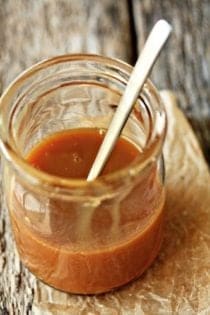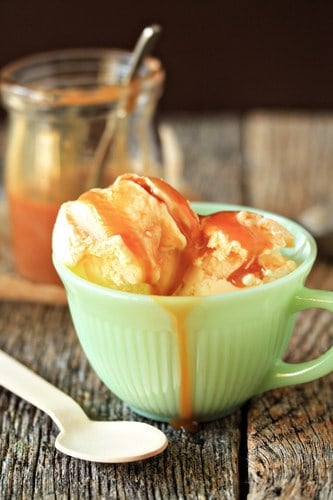This post may contain affiliate links. Please read our privacy policy.
Today is the beginning of a new recipe series I’m dubbing Fundamentals. I get a lot of emails from new bakers asking for basic recipes, tips, and product recommendations that will get them started with their newly acquired baking addiction.
While I can’t guarantee rock star status, I can provide you with some practical tips and simple tested recipes that work for me in my kitchen. The first recipe I am going to try and demystify is caramel, more specifically homemade caramel sauce.
I have a confession. Making caramel scares me. I love caramel, whether it’s by itself, sprinkled with sea salt, covered in peanuts, enrobed with nougat…well you get point. Although my love for caramel has been present for many, many years, I just recently started to make my own.
There have been some serious failures along one of which required the disposal of a pan. Yep, I tried to clean that sucker for days, so I ended up chucking it into the trash. Bottom line, caramel is finicky, it goes from perfect to a burnt mess in the blink of eye, but when you nail it, the outcome is extraordinary. Plus, you’ll never have to buy that overly sweet jarred stuff again!
On Friday, I’ll combine this luxurious caramel sauce with my Fleur de Sel Caramels to create one heck of a dessert!
Fundamental Information:
- Caramel is essentially melted sugar.
- There are two basic ways to make caramel: the dry method and the wet method. The dry method involves slowly heating sugar until it melts and is deemed as a bit more difficult. The wet method is more common and is what you will find in today’s recipe.
- In the wet method, granulated sugar is dissolved in water and then boiled until the water starts to evaporate. As the water escapes, the mixture goes through a series of stages that indicates the ratio of water and sugar.
Fundamental Gear:
- Heat safe spatula or wooden spoon
- Heavy bottomed pot (non-stick is easier to clean) – If using non-stick, it may be difficult to know if your caramel has reached the desired shade of amber. Simply use a heat safe utensil to remove a few drops of caramel to a white plate.
- Reliable candy thermometer – you will risk burning your sugar if you don’t have an absolutely accurate thermometer; cheapos from the supermarket typically don’t cut it.
Fundamental Safety:
- Give your undivided attention to the caramel sauce while you are preparing it.
- Caramel is HOT! Be careful. For reference- Water boils at 212°F, we are taking this sugar mixture over 350 degrees, so it’s incredibly hot.
- When you add the heavy cream to the pot of molten sugar, it will bubble violently and steam will escape. Stand back and keep your face away from the pot!
- Avoid a caramel catastrophe by making sure your heavy bottomed pot is large enough. Trust me; you do not want this caramel sauce to boil over onto your stove. It will bring you to tears. When you’re done, be sure to soak your pot and tools with hot water to help the cleaning process.
- Make sure your stirring utensil is heat proof. I typically use a wooden spoon or a silicone spatula.
Uses for Homemade Caramel Sauce:
- Eat it with a spoon
- Spoon it over your favorite ice cream
- Drizzle it over your favorite baked goods
- Stir it into your morning latte to create a homemade caramel macchiato
- Use it as a dip for fresh apple slices
- Jar these up and pass along to friends and family; just be sure to tell them it needs to be stored in the refrigerator
Homemade Caramel Sauce

Ingredients:
- 1 cup sugar
- 1 tablespoon light corn syrup
- 1/4 liquid cup water
- 1/2 liquid cup heavy cream, heated until warm
- 2 tablespoons unsalted butter, softened
- ½ teaspoon fine grain sea salt
- 1 teaspoon pure vanilla extract
Directions:
- In a heavy saucepan (at least 5 cup capacity), stir together the sugar, syrup, and water until the sugar is completely moistened. Place your candy thermometer into the pot taking care that it is tip in immersed into the sugar mixture.
- Heat, stirring constantly, until the sugar dissolves and the syrup is bubbling.
- Stop stirring completely and allow it to boil undisturbed until it turns a deep amber (like the color of Bass Ale) (see notes below).
- Immediately remove it from the heat and slowly and carefully pour the hot cream into the caramel. It will bubble up furiously.
- Use a high-temperature heat-resistant rubber spatula or wooden spoon to stir the mixture until smooth, scraping up the thicker part that settles on the bottom. If any lumps develop, return the pan to the heat and stir until they dissolve.
- Stir in the butter and salt. The mixture will be streaky but become uniform after cooling slightly and stirring.
- Allow the sauce to cool for 3 minutes. Gently stir in the vanilla extract.
Notes:
- Keep at room temperature for up to 3 days; refrigerated, about 3 weeks. To reheat, simply place in a microwave safe container and heat for about 45-60 seconds. Stir well.
- I have 3 thermometers and they all register different temperatures. In my opinion, it's best to rely on the color of the caramel as opposed to the temperature. You want to look for a dark dark amber color. However, dark amber goes to burnt in a matter of seconds. If using a thermometer, start paying close attention at about 340 degrees. Once the color deepens, pull the mixture from the heat.
Tempting Twist:
- Use fresh vanilla bean instead of vanilla extract. Simply scrape the seeds from inside ½ vanilla bean. Place the seeds and pod into the cream while it’s warming. Remove pod from the cream before adding to the hot sugar mixture.
Follow Jamie on Instagram. We love to see what you're baking from MBA! Be sure to tag @jamiemba and use the hashtag #mbarecipes!










Hi,
Is this caramel thick enough to use ‘thinly’ as a cake filling and can the cake be left out for 8-12 hours at room temperature (spring weather for a wedding cake)??
Danielle-
Although it has some thickness to it, my initial reaction is that it wouldn’t maintain its integrity as a cake filling. I would definitely give it a test run before the big day. Thanks for stopping by.
-Jamie
do you take your own photos? you are amaizng!
Carla-
Yes, I take all of the photos that you see on the site. Thanks so much for your kind words and for stopping by.
-Jamie
One of my Little Chefs made this while I supervised and instructed. We actually had to make this twice because the first time it burned. But it was good because we learned a few things for the next batch. It can still be improved for the next time, but considering the age of Little Chef A I think she did an amazing job! Check out our experience! http://www.fivelittlechefs.com/2012/02/homemade-caramel.html
I recently tried another caramel recipe and failed because of poor instructions! I wish I had found yours first. Next time, I’m going to use your recipe… consider this bookmarked!
I’m a bit of a lazy cook and I found the easiest way to make homemade carmel sauce is to boil sweetened condensed milk in the can, in water, for 3 hours, turning it every 1/2 hour or so. Comes out to perfection! I always let it cool down for a while before I open it up, so it comes out a bit like pudding, but if you wanted it thinner, you can nuke it in the microwave.
My mom did this for us every Christmas when we were kids, when she opened the can she let us dip full sized marshmallows in it, then dipped the caramel dipped marshmallows in shredded coconut or chopped nuts. It was our addition to the Christmas candy/cookie tray at family parties.
i can’t find this corn syrup, with what i can replace it
If you can go to a grocery store, you can find corn syrup. Literally every grocery store carries it in their baking section.
Usually with pancake syrup
I made this without a candy thermometer, as mine was broken. Batch 1, was afraid of burn, so the low temp evaporated off my water and it turned lumpy before browning. Batches 2 and 3, in a larger pan and higher temp (at least past half-way on the dial), just stared at it until I saw something that looked like “Bass ale” or “deep amber” and removed from heat. Batches 2 and 3 were amazing and almost the same. Thank you very much!
Good recipe for caramel sauce. I agree that the dry method is much harder than the wet method, the sugar so easily burns even on a low heat. I like that you warn the readers about the dangers of cooking this, as the first time I made this a few years ago I burnt my finger to 1st degree standard, just by dripping a bit of caramel accidently. It hurt, so readers take notice of the warning!
how do I keep my caramel from crystallizing ? I want to make it into threads, using just sugar and water?
with just sugar and water it is really, really hard. Basically the littlest thing can set up a crystallization reaction. This is why you add the corn syrup. It prevents the crystallization. You only need about a table spoon, and technically it is sugar.
If you’re trying to make threads, you don’t need to prevent crystallization – just make threads while the caramel is still hot. Cook a batch of sugar & water, and when it’s nearing the right consistency, dip in a fork and lift it up high to create threads. Then quickly gather them up by hand or onto a utensil.
So…did the same as Jacqueline Powers and basically burned my first batch. I’m gonna try again in the morning and take it off the heat way before it reaches 380…crossing my fingers!
Leslie-
Sorry you had a hard time with the recipe. I adjusted the recipe a bit and noted the edit. In my opinion, it’s best to use the visual color as opposed to the thermometer – all of my thermometers register different temps. What you are looking for is a dark amber color. However, it will go from dark amber to burnt in a matter of seconds. I hope this helps! Happy holidays to you!
-Jamie
Just wanted to let you know that my next batch was a SUCCESS! Thanks for this great recipe! :)